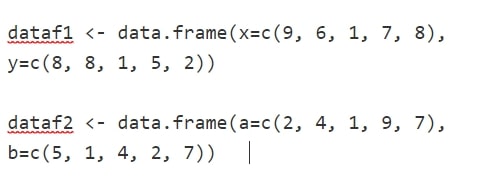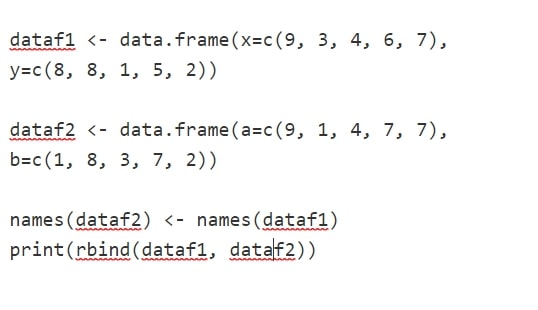Error messages are a constant byproduct of programming. A programmer will troubleshoot code more often than write it. This can be seen, for instance, in the “Error In Match.Names(Clabs, Names(xi)) : Names Do Not Match Previous Names” that is frequently encountered when programming in the R language. Therefore, I am here to guide you on how to fix this matter.
Key Takeaways
- This error occurs when the rbind() function is used on data frames with mismatched column names.
- This error hinders program execution, demanding resolution for seamless progress.
- Fixes include renaming column names automatically or manually, utilizing dplyr’s bind_rows(), and employing the rbind.fill() function from the plyr package.
I found the following main reasons for this error:
To understand why this problem happens, I recommend you learn how to execute it. Let’s look at the example of two data frames here:

Now, You must use the rbind() function on this:

The reason for “Error In Match.Names(Clabs, Names(xi)) : Names Do Not Match Previous Names” occurring is because the data frames have names that do not match. dataf1, the first data frame, has the column names as x and y, while dataf2, the second data frame, has them as a and b. You can even use the identical function to verify if the two are identical, and they’ll give you the boolean False.
Fixing “Error In Match.Names(Clabs, Names(xi)) : Names Do Not Match Previous Names”
Now I have told you why the error happens, I can move towards solving them. These methods also worked for Stack Overflow users. Here’s a list of ways that you can incorporate to fix “Error In Match.Names(Clabs, Names(xi)) : Names Do Not Match Previous Names”.
- Rename the Column Names Automatically
- Rename the Column Names Manually
- Use the dplyr packages to use the bind_rows()
- Use the plyr package to use the rbind.fill()
All these methods are pretty simple to employ. Therefore, if you follow these steps, it’ll be simple enough. Without further adieu, let’s get right into it.
Renaming The Column Names Automatically
To solve this issue, You can assign the column names of one data frame to the other. Here’s how you can do it:

Renaming The Column Names Manually
Once again, You can do the same thing; however, I do it manually this time. Here’s what the code would look like:

Use The dplyr Packages To Use The bind_rows()
First, you need to install the bind_rows function from the package that is dplyr. To install dplyr, and load it, here is what you do:
All you need to do is type in – install.packages(“dplyr”) followed by library(“dplyr”).
Following this, I will use the bind_rows() to form a new data frame from the preexisting data frames. Here’s how to do that:

While bind rows() may handle missing or mismatched columns, the rbind() function cannot. The bind rows() function assigns NA to the rows in the data frame where the columns were missing if there is an instance of a missing column.
The bind rows() function adds missing values to the data, but in some situations—such as when we wish to maintain column names or when the contents of the variables in the data frames differ—this can be better.
Use The plyr Package To Use The rbind.fill()
In this case, you can use the plyr function instead of the dplyr function. To install plyr, and load it, here is what you do:
All you need to do is type in – install.packages(“plyr”) followed by library(“plyr”).
Following this, I’ll use the rbind.fill to create a new data frame from the first two ones. Here’s what that looks like:

Rbind.fill can handle missing or mismatched columns, although the rbind() function cannot. The rbind.fill() function assigns “NA” to the rows of columns in the data frame where a column is missing if such is the case. Notably, bind rows and this function provide the same results ().
Final Verdict
Addressing the “Error In Match.Names(Clabs, Names(xi)) : Names Do Not Match Previous Names” is crucial for uninterrupted programming. Choose from the provided fixes, whether automated or manual renaming, using dplyr’s bind_rows(), or opting for plyr’s rbind.fill(), to ensure compatibility and resolve this common issue in R programming.
Frequently Asked Questions
Are there any other similar errors I might run into while using R?
Yes! A very similar error that you may encounter when coding in R is the R Error in rbind(deparse.level, ...): numbers of columns of arguments do not match.
As you can already tell by the name, this also has to do with the rbind function and the numbers of mismatching columns. It occurs when you try to use the rbind() function on two data frames that have the number of mismatching columns.
How can I solve R Error in rbind(deparse.level, ...): numbers of columns of arguments do not match?
You can get rid of this error in the same way as "Error In Match.Names(Clabs, Names(xi)) : Names Do Not Match Previous Names". All you need to do to take care of this error, is to attach the dplyr packages, in the same way as you would for any other error.
Following that, you apply the bind_rows function and tackle the error.
Is R the best programming language?
R is regarded as the best programming language for statisticians overall due to its extensive library of statistical and graphical capabilities. However, while being fundamentally equivalent to R, Python is preferred by data scientists and analysts due to its superior performance and ease of use.
What is the rbind() function?
Row binding, often known as a row-wise join or concatenation of two or more data frames, is carried out using the rbind() function.
How do I install R?
A source for locating R's sources, binaries, and documentation is the "Comprehensive R Archive Network" (CRAN) (see What is CRAN?).
Although not currently employing anonymous rsync, sources can also be retrieved through the R Subversion repository. (nor CVS).
What is the job of a Hex Editor?
A hex editor is a piece of software that can open and display hexadecimal files. Hexadecimal files are used to hold binary code, which is the basis for all editors. The name "hex" comes from hexadecimal, a format for expressing data.
These editors enable us to dissect the information provided by higher-level languages and pinpoint fundamental problems.
What is R?
R is a statistical computing and graphics system. It includes a language, a run-time environment, access to some system features, a debugger, and the ability to run programmes that are contained in script files.
What functionalities does R offer?
Branching, looping, and modular programming using functions are all supported in R, which is largely an interpreted programming language. The majority of R's user-visible features were created in R. The user can interact with C, C++, or FORTRAN-written methods for improved efficiency. The R distribution offers support for a wide range of statistical techniques.
How can I time my code in R?
You can do this using two functions and avoiding loops: proc.time and system.time. The proc.time command functions much like a stopwatch: you set the initial starting time, run all the appropriate code, and then stop it by deducting the initial starting time from the final stopping time.
Check my other fixes as well:
- Xbox One Error Code 0X87e107DF
- How To Fix 0x97e107df Xbox Error
- How To Fix Xbox One Error 0x876c0001
Good job! Please give your positive feedback
How could we improve this post? Please Help us.